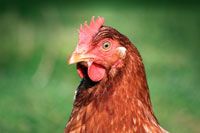To fight high maize prices, a KwaZulu-Natal poultry farmer is feeding his chickens worms to supplement their diet, but the "natural" feed has yet not been proven on an industrial scale, says South African Poultry Association CE Kevin Lovell.
Chris and Kandy Slater, owners of Croft Farms in the Midlands, are using a bucket system to grow maggots. Chicken litter is used to attract flies, which lay eggs that hatch to form maggots 20 days later.
The maggots are then fed to the chickens. It costs nothing to produce the grubs.
Chicken feed prices in Pietermaritzburg, one of two centres in SA where the price is benchmarked, rose about 38% last month compared with the same time a year ago. This has had an adverse effect on farmers' profits as between two-thirds to three quarters of production costs are made up of feed.
Investec Asset Management analyst Anthony Geard said yesterday that poultry companies were caught in a "perfect storm" of high prices for maize and soya, high levels of imported product and weaker demand caused by slower consumer spending.
Stellenbosch-based AgriProtein is, according to Farmers Weekly, commercialising the use of flies in the poultry industry by using their larvae to make a dried, natural feed. This is meant to be an alternative to fish meal, maize and soya - which make up the bulk of most commercial chicken protein feeds.
AgriProtein says on its website that using fly-feed could "eliminate the need for almost all fishmeal trawling, protect the seas, refresh natural stocks, while sustainably supplying farmed fish with the required nutrients".
Mr Lovell said wild chickens eat a certain amount of grubs to supplement their protein intake. Chicken is the second-largest source of protein in the world, costing about a third of the price of beef because dry feeding allows for the safe industrialisation of poultry production.
The prices of maize and soya for chicken feed are high because farmers had to pay for imported maize products last year, and due to the effect of drought on production in the US this year.
Source: Business Day













































